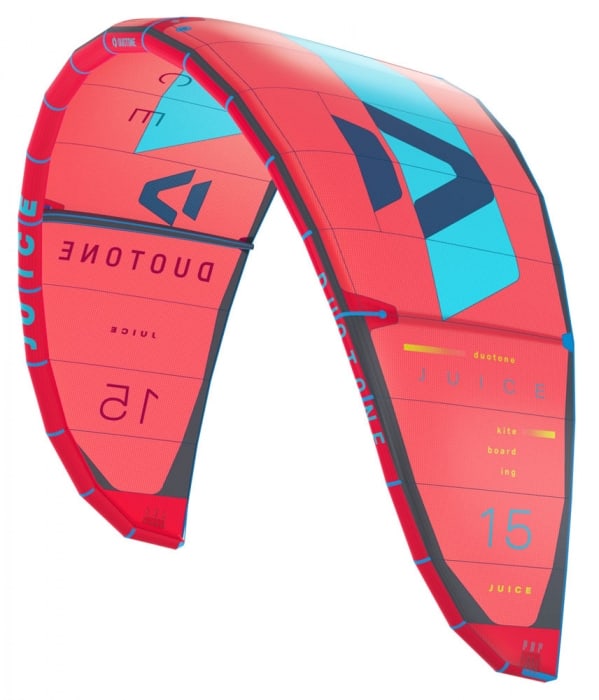| Model |
Juice by Duotone
|
| Year | 2020 |
| Shape |
Hybrid-Kite
|
|
Riding Type
|
Freeride, Foil
|
|
Riding Skill
|
Beginner – Intermediate
|
|
Available sizes
|
17,15,13,11 m²
|
Duotone’s new Juice has been heavily reworked and radically slimmed down: it should gain weight in the low end without sacrificing in the high end. Struts are used for the first time in the Juice Flex.
Twelve percent weight reduction may not sound like much at first. But for a light-wind kite these are worlds apart. In the lowest wind range, every gram counts. The lighter a kite is, the further down the low end can be stretched. Many manufacturers rely on one-strut constructions for this purpose. With the Juice, however, duotone designer Ralf Grösel remains true to his three-strut delta philosophy.
For the slimming cure, Duotone relies on a new, lighter Dacron and a strut construction made of new Ripstop, which according to Grösel saves about 50 percent weight compared to conventional Dacron struts. The new Flex Struts are used for this. With the flexible construction the kite should become more reactive and produce more pull at the same time. And Duotone has also eliminated everything else that is superfluous.
The Pulleys have disappeared from the bridle. The bridle lines are now also slimmer than on the predecessor. Even the bladders want to make Duotone lighter. For fine-tuning, the Brand offers three options for attaching the steering lines to the tip. Duotone will help you choose the right size: Each size should work in a wind range of about 8 to 18 knots; the weight of the rider and the use of a foil or a twin tip will determine which size is the right one. However, the sizes 11 and 13 should be a bit more suitable for use with a foil.
Duotone Juice 2020 – Performance
Once released into the air, the Juice is stable even with the tiredest breeze and will not let itself be thrown off balance even in gusty conditions under ten knots of ground wind. The lightweight Juice can easily keep up with the One-Strutters.
What’s more, the cloth has only minimal wrinkling, and being far more depowered, the Juice appears to have a cleaner airflow than the One-Strutters. The canopy stands full in the air, shows no downward tendencies and immediately conveys confidence.
The bar feeling depends on the connection to the tips. In medium setting it appears soft and subdued, in soft setting very light, but also somewhat indirect on the bar. In the hard setting, on the other hand, bar forces and feedback increase somewhat. Overall, steering and holding forces are in the middle range.
The tuning appears a bit softer on the bar and comfortable, typical for duotones. Only far depowered in the upper wind range feedback and reactivity decrease noticeably.
Although the Juice is not one of the most ultra-direct and agile kites, the 15 turns clean, fast and above all round. If you steer it hard, you can force it into the plate a little bit, but less clearly than Breeze, Ghost or Sonic.
In terms of airspeed it sorts itself between Breeze and Ghost. When inflating, you should look carefully at the pressure gauge and keep to the recommended filling pressure. If you pump up the Juice to full power, you will have a stiffer canopy on the hook, but the kite will also be slower in the air, as it will not be able to twist as much.
The Juice’s stretched Delta-Shape with its Flex Struts produces a lot of power even in the lowest wind range. One of its biggest advantages is the easy access to the low-end power. With a few precise sine curves downwards, you can still squeeze out a few knots, but like the Ghost and Sonic, the Juice can be flown in the earliest position and offers excellent control over the bar. With this distinct sheet-and-go handling it is easy to control even for beginners.
The kite produces pleasantly little cross pull. So you have easy play on the edge. This is also noticeable in the upwind performance. Although it can’t keep up with the high performance Sonic 3 and the thinner and smaller Breeze shifts the wind window by a few more degrees, the Juice still works perfectly when going upwind.
The depower is amply dimensioned and in combination with the good flight stability the Juice offers one of the biggest high-end reserves. Even medium-weight kiters around 80 kilos could easily fly the 15er up to the 20-knot mark with appropriate edge control. This also makes it suitable as the main size for heavier twin-tip freeriders.
On the foil, the 15er-Juice is solid in freeride and cruising use, but it lacks a little bit of turning joy and agility compared to the Breeze. The high flight stability and the linear pull in the lowest wind range help to get going without problems, and with the lush depower unpleasant gusts can be comfortably buffered. But those who appreciate agility for maneuver training tend to go for the smaller sizes.
Jumping – This is where the Juice comes out on top. It clearly leaves the one-strutter Breeze and Ghost behind, the Sonic offers enormous performance, but is much more difficult to jump. The Juice makes it easy to hit the jump. It pulls back gently without excessive cross pull and releases a powerful, long-lasting lift even when the jump is not cleanly hit. Some testers were surprised how high you can jump with a 15er. In addition, it offers good control and sufficient feedback in the air so that you always know where the kite is.
Summary
Less weight, more power – the Juice has gained over its predecessor and is suitable for freeriders and heavier kiters looking for an uncomplicated kite to have fun with in light winds.
